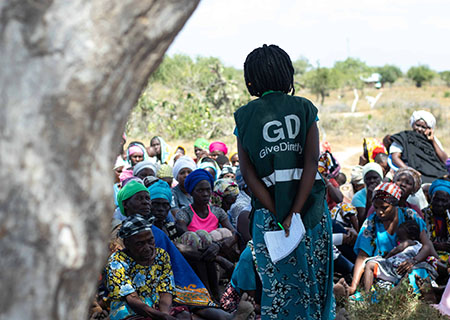Direct cash transfers for urgent needs
COVID-19 caused more than 150 million people around the world to fall below the poverty line.[1] Research has shown that cash transfers that can be spent on urgent needs — whether one-time grants or guaranteed income — are a powerful way to improve lives. GiveDirectly helps by sending no-strings-attached money to people who urgently need it.
What It Does
GiveDirectly transfers cash to people living in extreme poverty so they can meet their most urgent needs. Founded in 2009 as a private giving circle and opened to the public in 2011, GiveDirectly believes that people in poverty deserve to make their own choices about how to improve their lives, so the transfers have no conditions attached to them. They currently have operations in eight countries. GiveDirectly maintains strong partnerships with leaders at multiple levels of government and community, from district heads to village chiefs.
GiveDirectly’s longest-running programs deliver about $1,000 per family, saturating entire villages so that each household receives a payment. They identify participants using poverty data from national surveys, government lists, community-based-organizations, or partner apps like Propel, which provides SNAP benefits to millions in the United States. Recipients often spend grants on medicine, livestock, school fees, water, solar lights, irrigation, businesses to generate income, and more.
In response to the pandemic, GiveDirectly launched COVID-19 responses in Kenya, Malawi, Uganda, Rwanda, Liberia, DRC, and Togo. They adapted their model — which had previously included four in-person touchpoints — to be entirely remote and began giving in the U.S. as well, reaching 400k+ recipients affected by COVID-19.
How Effective It Is
GiveDirectly runs rigorous evaluations using randomized control trial studies to compare program participants vs non-program participants. These studies fill gaps in global evidence, inform the government and the public on the benefits of cash transfers, and enable GiveDirectly to reach more recipients.
GiveDirectly’s nutrition benchmark study compared the impact-per-dollar of unconditional cash transfers to Gikuriro, an integrated nutrition program in Rwanda. The study found that neither the nutrition program nor cost-equivalent cash transfers of $110 affected the study’s primary outcomes, but a larger transfer of $532 improved consumption, dietary diversity, and childhood growth 12 months after the baseline survey [2].
Cash transfers also have been shown to have positive effects on the neighbors of recipients. In a study published in 2019, GiveDirectly provided one-time cash transfers of about $1,000 to over 10,500 poor households across 653 randomized villages in rural Kenya. Over the 27 months studied, each $1,000 transfer increased spending by both recipients and nonrecipients by approximately $2,600[3].
How You Can Help
The extreme poverty line is $1.90 a day, meaning receiving this amount (or less) would lift someone above the line. 88% of GiveDirectly’s funds are sent directly to recipients, and the rest cover banking and mobile money fees, operations expenses, software, insurance, and auditing. With additional funds, GiveDirectly can reach more recipients. $100 can cover six children’s education costs for a year. $1,000 covers one household’s annual food cost, agricultural supplies, and home renovations. Learn more at https://donate.givedirectly.org/.
More Ways to Help — During COVID, cash relief efforts spurred interest in ongoing basic and guaranteed income programs. For example, SHOFCO, a community-based organization in Nairobi, Kenya, that provides clean water, community latrines, healthcare, early childhood education, business skills training and facilitation of group savings and loan programs, now works with GiveDirectly to enroll households in cash transfer programs. In the United States, Springboard to Opportunities introduced the Magnolia Mothers Trust, which provides $1,000 cash on a monthly basis, no strings attached, for 12 months straight to extremely low-income, Black mothers living in affordable housing in Jackson, MI.
Notes
[1] Mahler, Daniel G., Nishant Yonzan, Christoph Lakner, R. Andres C. Aguilar, and Haoyu Wu. 2021. “Updated estimates of the impact of COVID-19 on global poverty: Turning the corner on the pandemic in 2021?” World Bank Data Blog. https://blogs.worldbank.org/opendata/updated-estimates-impact-covid-19-global-poverty-turning-corner-pandemic-2021.
[2] Benchmarking a WASH and Nutrition Program to Cash in Rwanda.” Innovations for Poverty Action.
https://www.poverty-action.org/study/benchmarking-wash-and-nutrition-program-cash-rwanda

